GANTA CITY CAMPAIGN . LIBERIA
SURGEONS IN ACTION
IN COLLABORATION WITH HERNIA INTERNATIONAL
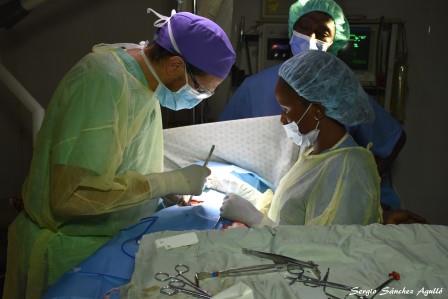
1. TECHNICAL REPORT
a. DATES AND DEPLOYED LOGISTICS:
A team of 7 people: 3 general surgeons, a pediatric surgeon, an anesthesiologist, a surgical nurse and a professional photographer.
11 packages with a total of about 220kg of surgical material and medicines.
Departure from Madrid on Friday 22 and arrival in Madrid on Saturday 30 September.
Saturday 23/9: Evaluation of patients already preselected by Dr. George.
Sunday 24-Friday 29/9: Surgical interventions, from 8:00 a.m. to 6:00 p.m., in 3 operating rooms. Friday from 8:14 p.m.
b. ADULT PATIENTS:
91 procedures have been performed in adults. 36 in women and 56 in men.
Inguinal hernia: 62, procedures. In all but 2 Shouldice, anterior hernia repair was performed, type Lichtenstein, with mosquito mesh:
41 rights and 21 left.
Of these, 10 were bilateral inguinal hernias, in another patient an epigastric hernia was operated in addition to the inguinal hernia, and in one patient an appendectomy was associated, since the appendix was included in a large recurrent hernia.
35 were scrotal and 22 giants. 6 were recurrences of previous herniorrhaphy without mesh.
Crural hernia: 4 (Lichtenstein plug with mosquito mesh)
Epigastric and umbilical hernias: 16, one of them was recurrent. (4 raphys)
Other procedures: 3 hydroceles (giants), 1 cryptorchidism, 2 testicular tumors, 1 lipoma, 1 bilateral inguinal abscessed lymphadenopathys and 1 nail abscess.
c. PEDIATRIC PATIENTS:
61 procedures were performed in pediatric patients, 49 in children and 12 in girls, from 7 months to 14 years of age.
Inguinal hernia: (rafias)
27 right, 21 left. 3 of them bilateral.
Other procedures: 2 cryptorchidias (orchidopexy), 9 umbilical hernias and 2 hydrocele
Total procedures: 152
Total patients: 129, 103 males and 26 females.
d. COMPLICATIONS:
Until leaving Ganta City on Friday afternoon, all patients were discharged after one night of hospitalization, without complications, except for one patient with a recurrent epigastric hernia, who underwent a Rives retromuscular hernioplasty, which remained hospitalized for 2 days. Patients operated the same Friday, were admitted to waiting for discharge the next day. According to Dr. George’s later report, the only complication has been a surgical wound dehiscence.
2. MEMORY OF THE CAMPAIGN
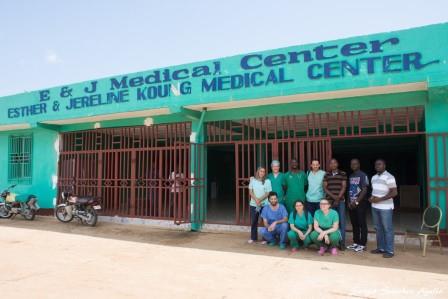
a. THE PLACE
Liberia is a West African country bordering Sierra Leone, Guinea Konacri and Ivory Coast. It has an estimated population of about 4.2 million, of which 85% are estimated to live below the international poverty line, and ranks 6th among the world’s poorest countries, in the last annual report of the UN, with an annual per capita income of $ 518. He lived a moment of peace since 2003, with the first democratic elections in 2005. His social and economic recovery was seriously threatened by the Ebola epidemic of 2014, in which more than 4,500 people died. During the months of October and November this year the Liberians are called to the polls to elect their new president, among more than 50 candidates.
Ganta City is a town in Nimba County, Liberia’s largest and most populous city. It has a paved main street, which is the commercial center of the town, although most of the streets are dirt, and the vast majority of its population lives in very simple constructions. The access to this population is made by road, built by a Chinese company, in very good condition, and that crosses the whole country from Monrovia, from west to east, in a journey of about 4 hours from the airport.
E & J Medical Center is Ganta City Hospital, and its medical director is Dr. Peter George. The hospital has a very limited means of attending to the population, which the employees of the hospital, and expressly Dr. George as responsible, fill with an enormous capacity for work and ingenuity. They have a basic laboratory, a pharmacy, adult and pediatric hospitalization rooms, emergency room, delivery room, and two operating rooms. It was surprising to see that the hospital is kept in clean conditions more than acceptable. Among the serious shortcomings of such a hospital, it is clear to us that it is difficult to maintain adequate asepsis circuits of the surgical material, a subject to which we will deal later.
During our stay in the hospital, we used the two operating rooms full time, one exclusively for pediatric patients, and one for adults. In addition, we have enabled another room for a third operating room, which we have also used for adult patients.
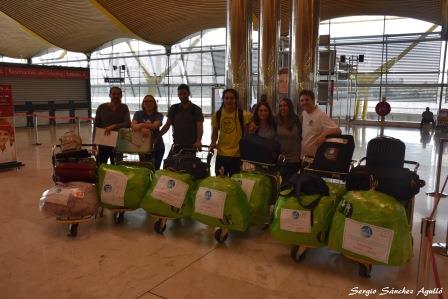
b. THE TEAM
On 22 September, Friday afternoon, a team of 7 people left Madrid destination Monrovia:
-Carlos de la Torre Ramos, pediatric surgeon,
-Sebas Fernández Arias, general surgeon,
-Ana Gay Fernández, general surgeon,
-Bea Revuelta Alonso, anesthesiologist,
-Nuria Agulló Marín, a surgical nurse,
-Sergio Sánchez Agulló, photographer,
-David Fernández Luengas, general surgeon, leader of the campaigns.
This campaign was carried out by a team of the Surgeons in Action Foundation, in collaboration with the NGO Hernia International, following the agreement signed by the latter with Hospital E & J Medical Center. This is the second campaign to Ganta City, after the first of a team of Hernia International in July, which opened the way to what is likely to become one of the locations most appreciated by the organization, due to both the huge needs of the population and the willingness of all local hospital staff to collaborate and participate in the campaigns.
Together with the medical team, this time a professional photographer participated in the campaign, with the objective of collecting audiovisual material to carry out a documentary film on this place, its reality, its needs, and the task that the Foundation Surgeons in Action and Hernia International carry out here.
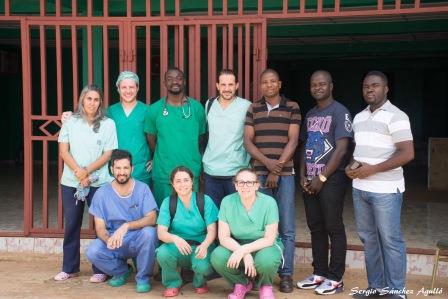
c. THE LOCAL PERSONNEL
In the hospital there are currently only two clinicians, including Dr. George, medical director and specialist in Gynecology and Obstetrics. In addition, they have a head of Anesthesia, who leads a team with 2 other anesthesia technicians. For our work, we had two assistants in each operating room, who worked as scrub nurses and circulating in the operating room. It is fair to acknowledge to all of them the enormous effort made and the joy with which they have shared the work with us. Their deficiencies in surgical training have been supplemented by their dedication and willingness to work. We were very pleased to note upon our arrival the cleaning of the facilities, which we were able to check as they were kept day after day by the cleaning staff.
It was very exciting the welcome ceremony, just after arriving at the hospital, and was even more the ceremony of farewell, with the central waiting room crowded, in which we deliver diplomas of participation to all the participating staff, made by Dr. George, and we were delivered to the whole team some beautiful gifts that we deeply appreciated.
Dr. George, as Medical Director, sets an example with a tremendous capacity for work, and conveys that involvement to all staff. We have always provided an anesthesia technician and two auxiliaries. All our belongings were guarded daily in Dr. George’s office, locked, and with the presence of a security guard at all times, although our feeling was that it was not necessary at all, given the tranquility that was lived inside the hospital . The management of the hospital has put at our disposal a 7-seater SUV, with its driver, who has transferred us daily from the hotel to the hospital, and back, at any time, and always with a smile. In addition, they took care of our transfer to and from Monrovia airport, in a journey that lasts about 4 hours.
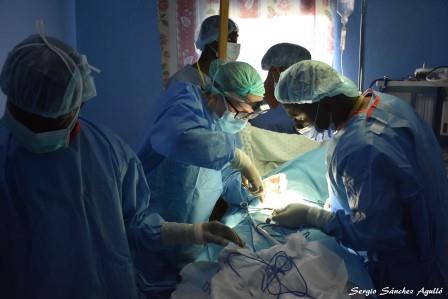
d. THE EQUIPMENT
The hospital has very limited means. In terms of our work, each of the three operating rooms have anesthesia equipment, one of them quite modern, but absolutely useless since there is no oxygen or anesthetic gases. The operating tables are acceptable and the lights perfectly valid. The hospital has a relatively stable electricity network, from 8 am to 7 pm. There are oxygen concentrators and basic monitoring systems for blood pressure, heart rate and 02 saturation. There are several equipments of surgical instruments in acceptable conditions. Our team carried two sets of adult surgical instruments that did not need to be used, and two sets of pediatric instruments, which we divided into 4 and used constantly for pediatric patients. Regarding consumables and surgical clothing, the needs are enormous. We have used practically all the material we have carried, more than 200kg among gauzes, compresses, gloves, dressings, sterile disposable cloths, sterile disposable gowns, iv anesthetic medication, iv antibiotics for prophylaxis, mosquito meshes and antiseptics, among other things. Without this material, to raise a campaign of these characteristics to this place is impossible. The next teams should be very aware of the need to provide all this material. Each of the two surgical operating theaters have their electrocautery generator. For the third operating room that enabled us, we carry from Madrid a generator owned by the Foundation Surgeons in Action. It is fundamental to carry both the adhesive earthing plates and the electrocautery terminals, since there are practically none.
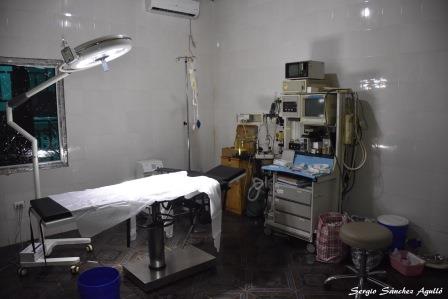
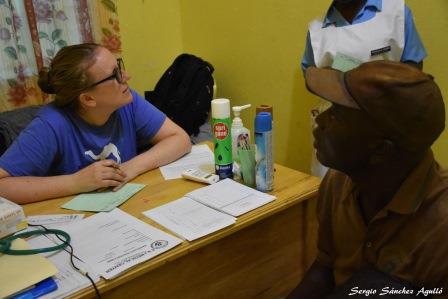
e. THE DAILY WORK:
Our day begins every day in the hospital at 8:00 a.m. We arrived there from the hotel in a vehicle provided by the hospital, which moves us every day. Except on Saturday, the day of our arrival at the hospital, that we were checking the prescheduled patients, about 50 adults and 20 children, the rest of the days from Sunday until Friday afternoon we dedicated all the time to operate, and Dr. George was in charge of selecting new patients. Before starting each day of surgery, we carried out the ward consultation of patients operated the day before. We operated every day in the three operating theaters, except for some interruption to attend emergencies, mainly cesareans. In an important part of pediatric patients, the pediatric surgeon has received assistance from one of our general surgeons. Also, in the vast majority of adult patients, a general surgeon of our team was assisted by local staff. During two days, we had the presence of a medical student from Monrovia, in his surgical rotation, who received a valuable surgical training for his profesional future, in which the surgical skills are very necessary. The days have become short, working with great intensity, well into the afternoon, sometimes beyond 19h. We paused to eat, a delicious “wrap” kebab style, which Dr. George entrusted us daily. It is important to emphasize, for new teams, that this food must be paid to Dr. George, as stated in the agreement signed with Hernia International, as well as the fuel of the vehicle. Our daily work, it is important to point out once again, it has been very well appreciated by all the local staff, who have always been willing to help us, collaborating at all times to make the whole process more agile. Undoubtedly, it is the campaign in which we have received better local support, all of which we have participated the various members of the team. Regarding the safety of the team, we must point out that at all times we have worn face masks and goggles, and we have used double gloves. We have taken antiretroviral medication with us for a possible accident that fortunately has not happened, and we have completed malaria prophylaxis according to international guidelines.
i.
ANESTHESIA
There are two fundamental considerations here. One, on equipment and anesthetic material. The other, about the personnel dedicated to anesthesia.
The anesthesiologist of our team, supported by our nurse, have devoted almost all their attention to pediatric anesthesia, which has been the most complicated. Taking into account the absence of supplemental oxygen and anesthetic gases and, therefore, the impossibility of performing general anesthesia with orotracheal intubation, she has been forced to handle pediatric patients by the general combination of ketamine , fentanyl, midazolam and atropine, with constant manual ventilation and basic monitoring. Obviously, her professionalism and problem-solving ability have made it possible to conclude all interventions without serious problems, but it is obvious to emphasize the need to improve in this regard for the next campaigns. For this, it is very necessary for the hospital to provide supplemental oxygen and anesthetic gases.
It is important to note that a significant part of the anesthetic medication has been provided by us.
With regard to the local team, once again we must emphasize their great willingness to work and its great effectiveness. The head of Anesthesia, Abenego, has been a great help to all, very well supported by his anesthesia technicians, Brendan and Jonsi, who have practically never failed in spinal anesthesia. Our congratulations and thanks to all of them.
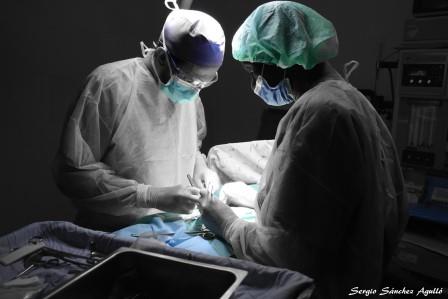
ii. ASEPSIS AND SURGICAL MATERIAL
Undoubtedly this is the great weakness of this hospital. There is little to analyze. Basically, they have a “sterilization” room where they store the packages with the sterile material, and a patio where two autoclaves of the type “express pot” with a pressure gauge are placed on wood fire. The system itself is rudimentary, but effective to achieve sterilization of the material.
The big problem is the asepsis circuit. With very little material, the instrument sets are left open from one operation to another to distribute the material of each set between two or more interventions.
Surgical clothing is very scarce, with very few cotton gowns and resterilizable surgical cloths. For this reason, they usually use non-sterile paper gowns to dress the surgeon and the instrument table, and some very small sterilized cloths to dress the patient sparingly. We use a large amount of disposable cloths that we carry from Madrid, as well as disposable gowns. Unfortunately, the gowns were finished, and although we tried to force the constant resterilization of cotton gowns, having so few, we had to operate on many occasions with the non-sterile paper gowns. The local staff always wore these paper gowns, associated with their errors by the lack of knowledge of what a sterile field means, they made us constantly watch over them in order not to lose sterility.
We have been particularly concerned that all of our adult patients receive a dose of cefazolin 2gr iv in anesthetic induction, which we have taken.
Another problem arising from this situation was the reuse of the electrocautery terminals. Although we carried a large number of them, they were not enough for the 129 patients, so we had to devise a way to “resterilize” this material. As it is not possible to heat them in the autoclave, we arranged containers in which we submerged the terminals, once cleaned, in a solution of 2% alcoholic chlorhexidine.
These problems must be resolved urgently. We have explained to Dr. George the situation, and he has understood the need to provide the hospital with more stringent asepsis circuits and resterilizable surgical clothing.
Regarding the surgical material, the situation is equally bad, as it corresponds to the type of hospital that it is. We carried a lot of material that is essential for other missions to take equally, from gauze and compresses to sterile gloves, drainage, dressings, steri-streaps, sutures, elastic bandages, etc.
Of course, there are no meshes for performing hernioplasties. We have carried a large number of “mosquito” meshes, sterilized thanks to the work of Hernia International, which sterilizes, packs and labels individually, and from here we take the opportunity to thank. In addition, we have carried some larger polypropylene meshes (30x30cm, for large incisional hernias that we have not done in this campaign, but that are often done) and some double layer mesh to ensure some special needs.
Surgical instruments are acceptable. In fact, the two sets of adult instruments we had was not necessary to use them. We also carried two sets of pediatric instruments, which we converted into four, and which we use constantly.
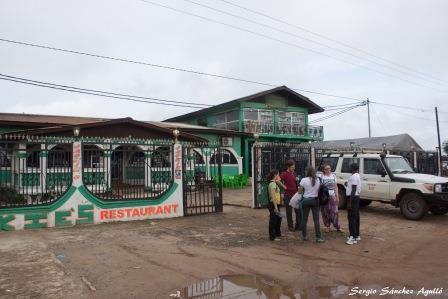
f. OUR LIFE IN GANTA CITY
Our life in this place has been very simple. We have always felt very well treated and well accompanied. Apart from the hospital life, which occupied much of the day, our life was practically limited to seeing the town in every way from the car window, and to enjoy the hospitality of Jackie’s Guest House.
That is the name of our hotel. Probably the only hotel to which we can go in conditions of health and safety, and that other international organizations use aswell, with which we have meet there. It is not a luxury hotel, as it can be understood, and yet it is quite expensive given the situation of the country, probably because it is used by all foreigners, and for that the costs raise enormously. We paid $ 50 for each room per day, not including breakfast nor dinner, which we also made at the hotel.
The rooms are clean, with fridge and TV, and with a 1.35m bed. The bathroom is ok, although the water flow in some rooms was quite meager.
The food has been equally good, none of the team members has had gastrointestinal problems, and we have enjoyed some variety. Definitely the best thing about each day was being able to enjoy a large bottle of 75cc local beer called Club Beer, well cold, which was an absolute pleasure that none will easily forget.
The hotel has a wireless network that has allowed us to communicate with the outside, but with frequent interruptions.
Overall, Ganta City does not have much to do, and it is not overly recommendable to wander around the city either. The concept “tourism” is very far from this place.
We had the opportunity to spend a few hours in Monrovia, in the late night before boarding back, but also did not give us time to visit some of the most emblematic places of the city, so we can not tell much about this. From the rest of the country, what we could see during the road trips. Basically, leafy jungle, flat, and population nuclei of great poverty, with a lot of motorcycle traffic and very simple constructions.

3. CONCLUSION
In short, this campaign has been a success, both for the number of patients we have been able to operate, without complications, and for the satisfaction of the team for the great treatment received by the authorities and local staff.
Undoubtedly, this place has become, in its own right, an important goal for our organization. There is much to be done, and the people here are looking forward to help.
Strengths of this place:
– Dr. George, the hospital’s real engine.
– The hospital itself, a real luxury for this place, with a very needy population, plunged in poverty.
– The way they take care of foreign teams.
Objectives of improvement:
– Aseptic circuit and sterilization of material. An urgent need to expand the surgical material, currently very deficient, and improve the asepsis methods.
– Training of auxiliary staff in the operating room and in basic rules of asepsis and antisepsis.
– Anesthesia equipment with supplemental oxygen and anesthetic gases.
– Improve the available surgical instruments and surgical material.
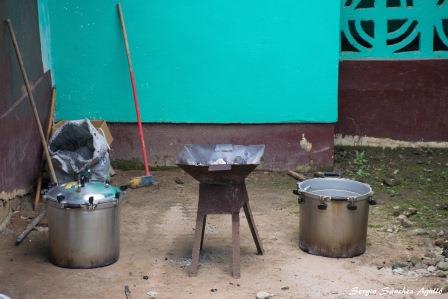
4. BUDGET:
For information, and without going into too much detail, it must be said that the campaign to Liberia is comparatively more expensive than others. This is due to two fundamental reasons. One, the cost of the fligth, significantly more expensive than in other locations. Two, the costs of lodging and maintenance
David Fernandes

